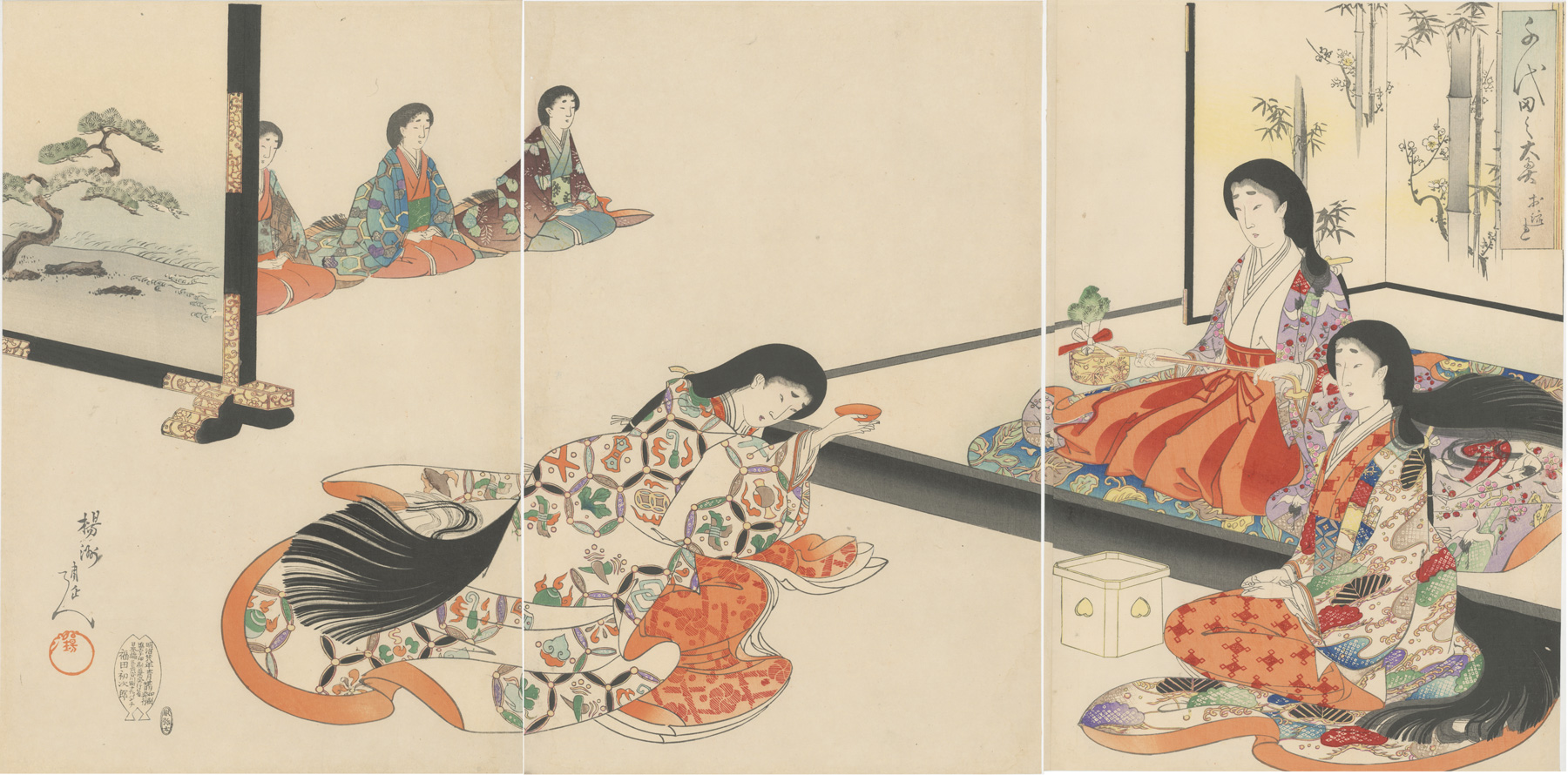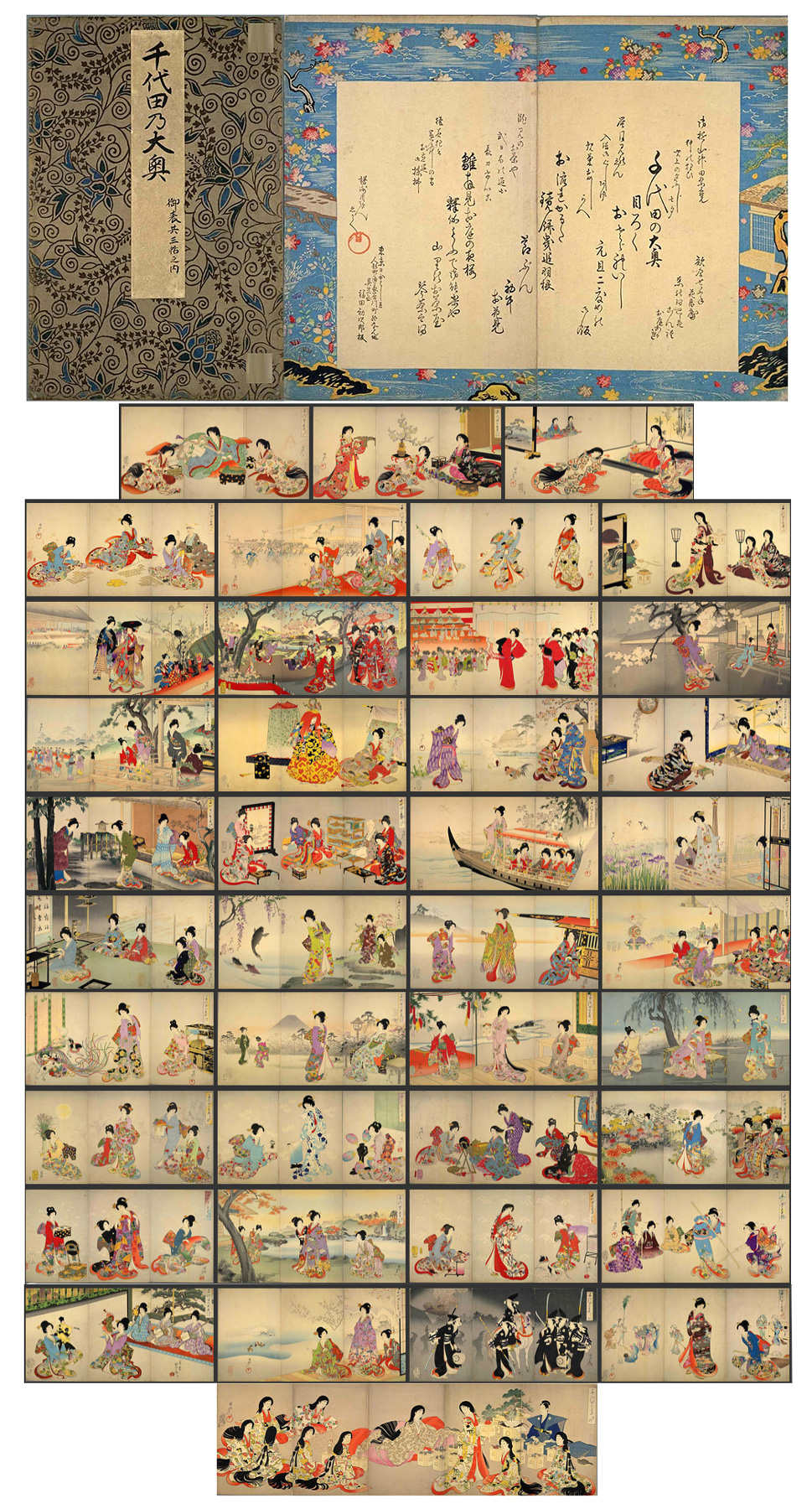About This Print
This print, from a series of 40 scenes documenting life inside the women quarters of the shogun's palace in Edo prior to the Meiji Restoration, depicts the New Year's day serving of spiced rice wine, as described below.Source: Chikanobu – Modernity and Nostalgia in Japanese Prints, Bruce A. Coats, Hotei Publishing, 2006, p. 172.
On the first morning of the new year, a special spiced wine (otosu) is drunk before breakfast and thought to bring good health throughout the coming year. Usually the youngest member of the family or group is served first, and in Chikanobu's print, a young woman raises a red lacquered wine cup to receive the invigorating brew from Inner Palace matron (jōrō toshiyori), while older women solemnly wait their turn in the background. The beverage is made by steeping overnight various flowers, herbs and roots in sweet rice wine (mirin). The two folding screens are painted with pine, bamboo, and plum branches (shōchikubai), the traditional evergreens and early blossoms associated with the new year.
About The Series
click on image to enlargeAfter completion of the series in 1896 the publisher compiled albums of all forty prints, plus a table of contents. "In the series "The Inner Precincts of Chiyoda," Chikanobu imagines something he never saw—the inner precincts of Edo Castle, which housed the shogun’s mother, wife, and concubines. The area was off limits to all men other than the shogun himself or his young male heir."1
"The Chiyoda Inner Palace (Chiyoda no Ōoku) series of 1895-1896, together with his 1897 series Chiyoda Outer Palace (Chiyoda no on-omote) provided detailed depictions of life in and around Edo Castle before the Meiji Restoration of 1868. In the Chiyoda Inner Palace set, Chikanobu documented various annual ceremonies in the women’s quarters, especially those at New Year’s, and seasonal activities, particularly those conducted in the palace gardens. While Chikanobu did not indicate specific events or name certain people that would link these images to a single date or time period, the scenes give an overall impression of what the shogun’s private quarters might have looked like in the mid-19th century.
"Most women depicted in Chiyoda Inner Palace are portrayed as elegant dignified ideal feminine figures, showing little emotion or excitement. No one seems happy or sad, ebullient or upset. In fact, these imaginary depictions suggest a realm of tranquil harmony, without conflict or illness. Only two old women are shown, and most of the more than 150 featured figures are youthful looking, appearing to be in their 20’s or early 30’s. A few girls are present, but even they are well behaved; no babies or pregnant women are evident. There is a sense of tension among the women, though, as ritual gestures and prescribed ceremonies are carried out with great seriousness. Although some settings are animated by secondary figures (servants,
actors, parade participants, etc.) or pet animals, overall the quiet rhythm of life in the Chiyoda Inner Palace is predominant and well described."2
click on image to enlarge After completion of the series in 1896 the publisher compiled albums of all forty prints, plus a table of contents. | "In the series "The Inner Precincts of Chiyoda," Chikanobu imagines something he never saw—the inner precincts of Edo Castle, which housed the shogun’s mother, wife, and concubines. The area was off limits to all men other than the shogun himself or his young male heir."1 "The Chiyoda Inner Palace (Chiyoda no Ōoku) series of 1895-1896, together with his 1897 series Chiyoda Outer Palace (Chiyoda no on-omote) provided detailed depictions of life in and around Edo Castle before the Meiji Restoration of 1868. In the Chiyoda Inner Palace set, Chikanobu documented various annual ceremonies in the women’s quarters, especially those at New Year’s, and seasonal activities, particularly those conducted in the palace gardens. While Chikanobu did not indicate specific events or name certain people that would link these images to a single date or time period, the scenes give an overall impression of what the shogun’s private quarters might have looked like in the mid-19th century. "Most women depicted in Chiyoda Inner Palace are portrayed as elegant dignified ideal feminine figures, showing little emotion or excitement. No one seems happy or sad, ebullient or upset. In fact, these imaginary depictions suggest a realm of tranquil harmony, without conflict or illness. Only two old women are shown, and most of the more than 150 featured figures are youthful looking, appearing to be in their 20’s or early 30’s. A few girls are present, but even they are well behaved; no babies or pregnant women are evident. There is a sense of tension among the women, though, as ritual gestures and prescribed ceremonies are carried out with great seriousness. Although some settings are animated by secondary figures (servants, |
Chiyoda Palace History
Source: Wikipedia http://en.wikipedia.org/wiki/Edo_CastleChiyoda Castle (千代田城, Chiyoda-jō) also known as Edo Castle (江戸城, Edo-jō), is a flatland castle that was built in 1457 by Ōta Dōkan. It is located in Chiyoda in Tokyo, then known as Edo, Toshima District, Musashi Province. Tokugawa Ieyasu established the Tokugawa shogunate here. It was the residence of the shogun and location of the shogunate, and also functioned as the military capital during the Edo period of Japanese history.
After the capitulation of the shogunate in 1867, the inhabitants including the shogun had to vacate the premises. The castle compound was renamed Tokyo Castle (東京城, Tokyo-jō) in October, 1868, and then renamed Imperial Castle (皇城, Kōjō) in 1869. In the year Meiji 2 (1868), on the 23rd day of the 10th month, the emperor moved to Tokyo and Edo castle became an imperial palace.
1 Portland Art Museum http://portlandartmuseum.us/mwebcgi/mweb.exe?request=record;id=46772;type=101
2 Chikanobu – Modernity and Nostalgia in Japanese Prints, Bruce A. Coats, Hotei Publishing, 2006, p. 169.
Print Details
| IHL Catalog | #1245 |
| Title or Description | Serving Spiced Rice Wine Onagare お流れ |
| Series | Chiyoda Inner Palace Chiyoda no Ōoku 千代田之大奥 |
| Artist | Yōshū Chikanobu (1838-1912) |
| Signature |  |
| Seal | Toshidama 年玉 (as shown above) |
| Publication Date | December 2, 1895 (明治廿八年十二月二日 Meiji 28th year, 12th month, 2nd day) |
| Publisher |  [Marks: pub. ref. 070; seal ref. 062] |
| Carver |  |
| Impression | excellent |
| Colors | excellent |
| Condition | excellent – full-size sheets; unbacked; minor soiling |
| Genre | ukiyo-e |
| Miscellaneous | |
| Format | vertical oban triptych |
| H x W Paper | 14 7/8 x 10 in. (37.8 x 25.4 cm) each sheet |
| H x W Image | same as paper size |
| Literature | Chikanobu – Modernity and Nostalgia in Japanese Prints, Bruce A. Coats, Hotei Publishing, 2006, pl. 96, p. 172. |
| Collections This Print | The Metropolitan Museum of Art JP3522; National Diet Library NDL call number 寄別8-5-2-1; Scripps College Ruth Chandler Williamson Gallery 2013.1.2 |
3/7/2020



